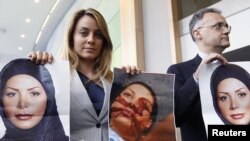A decade has passed since Iran held its most bitterly contested elections ever, the aftermath of which shook the Islamic republic to its core over allegations of mass electoral fraud.
Massive demonstrations and counter demonstrations by protesters and state supporters raged across major cities for 19 months, nowhere more so than in the capital Tehran, in what was later described by Iran's supreme leader Ayatollah Ali Khamenei as the "edge of the abyss".
As the world watched on in amazement, the so-called Green Movement that started out with "silent" demonstrations against ultra-conservative Mahmoud Ahmadinejad's re-election as president and demands for an independent recount evolved into running battles between protesters and security forces.
The advent of camera-equipped mobile phones and the spread of the internet meant images of the protests fanned out quickly, causing the main focus of the demonstrations to switch from electoral fraud to repression.
The determination of the state to stamp out what it considered to be "sedition" at any cost, including mass trials and death sentences, gradually brought the movement to a standstill.
One of the reformists arrested in the first wave of the crackdown was journalist and activist Ahmad Zeidabadi.
"History will look back at the defeat of the green movement as a bitter event that left its supporters extremely and deeply frustrated and disillusioned," said Zeidabadi, who was detained the day after the election.
Amir Mohebbian, a conservative politician and analyst, said the circumstances had changed in many ways since 2009 when "the state realised that the opposition and America" were behind the riots, and therefore used its "full powers to take control of the situation".
- 'Where is my vote?' -
The 2009 election campaign might well have been one of the most dynamic in the Islamic republic's history.
The one-on-one TV debates between candidates changed the mood of the campaign from festive to a bitter face-off, none more so than an explosive encounter between Ahmadinejad and his main challenger Mir Hossein Mousavi.
On Friday, June 12 when polling stations opened, the turnout -- officially at 85 percent -- forced voting hours to be extended late into the night.
The first signs that something had gone awry came when Iranians realised the SMS messaging system had been disabled overnight.
Reformists soon claimed telephone lines to their vote tallying centres had been cut and many observers had not been allowed to enter polling stations.
Later on, some of Mousavi's main campaign centres in Tehran were closed by security forces.
Mousavi held an impromptu press conference late at night and claimed victory, warning that any reports to the contrary would be a sign of fraud.
The final official count showed Ahmadinejad had won with nearly 63 percent of the vote, and within hours sporadic protests began in Tehran and soon spread to other major cities.
As the vote breakdown was published, reformists pointed to irregularities and claims of mass fraud gained traction.
Ahmadinejad's victory rally on June 14 in which he called protesters "dirt and rubbish" riled many voters.
When Mousavi and the other reformist candidate Mehdi Karroubi, who had officially gained 34 and one percent respectively, called for a counter rally in Tehran on June 15 the response by supporters was beyond expectations.
There is no official figure as to how many took part in the demonstration on that Monday but reports from different political factions claimed more than three million marched in silence onto Azadi (Freedom) Square.
Holding banners asking "Where is my vote?", they waved green flags, Mousavi's official campaign colour.
- 'Heartbreaking' death -
Demonstrations continued throughout the week with reports of clashes between protesters and security forces.
The authorities demanded that candidates pursue complaints through the Guardian Council, tasked with supervising elections.
A recount of 10 percent of ballot boxes was held, confirming Ahmadinejad's victory, but his challengers contested the council's neutrality and refused to accept its ruling.
On Saturday, June 20 another massive rally in central Tehran turned violent as protesters and security forces clashed.
Though local and foreign media were now banned from attending the rallies, many powerful pictures and videos emerged.
One depicted the shooting that day of Neda Agha-Soltan, a student in her 20s, whose death was described as "heartbreaking" by then US president Barack Obama.
That Saturday's protests were among the bloodiest, only matched by the fierce clashes on December 27, 2009.
Though gradually declining in size and frequency, the protests went on until February 2011, the last time Mousavi and Karroubi called for demonstrations before authorities placed them under house arrest, where they now remain.
It was never known how many people lost their lives or were wounded during the protests. The state says dozens were killed, mostly by "seditionists".
For Ali Shakouri-Rad, one of the last active reformist politicians, Iranians have since moved on and have become "occupied with issues other than elections, such as the economy".
Politician and analyst Mohebbian said the people and the state had come to a compromise: the Islamic republic "would not constrain the social lives of people beyond some nominal actions" and in return the people would to a degree "support the state in the (present) circumstances".
For many international observers, though, it was the "summer of Tehran" that inspired the Arab Spring uprisings that began at its demise.






